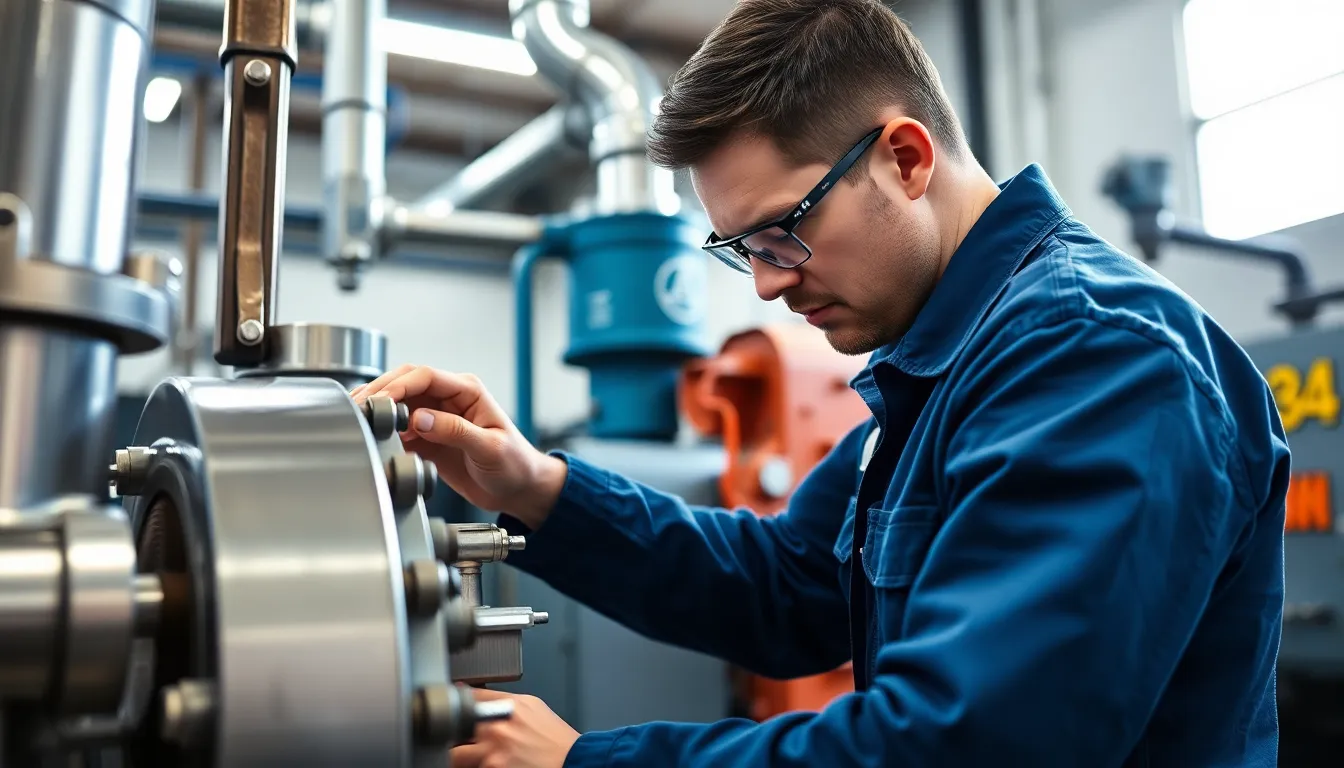Pumps are vital components in various industries, ensuring smooth operations in everything from water supply systems to manufacturing processes. When a pump fails, it can lead to costly downtime and disruptions. Understanding the intricacies of pump repair not only saves money but also extends the lifespan of this essential equipment.
Whether dealing with a minor leak or a complete breakdown, knowing how to troubleshoot and repair pumps is crucial. This article explores common pump issues, effective repair techniques, and maintenance tips to keep pumps running efficiently. With the right knowledge, anyone can tackle pump repair challenges confidently and minimize operational hiccups.
Table of Contents
ToggleOverview of Pump Repair
Pump repair involves the systematic assessment, troubleshooting, and restoration of pump functionality for optimal performance. Understanding common pump failures enhances repair success rates and minimizes downtime. Experienced technicians typically follow steps that include diagnosing issues, sourcing replacement parts, and performing repairs.
Common Pump Issues
- Leaking Seals: Seals can degrade due to wear, temperature fluctuations, or chemical exposure.
- Bearing Failures: Bearings often fail from inadequate lubrication or misalignment.
- Cavitation: Cavitation occurs when the pressure drops, leading to vapor bubbles that can damage the impeller.
- Blockages: Foreign materials can clog the pump impeller or piping, reducing efficiency.
Effective Repair Techniques
- Seal Replacement: Technicians replace worn seals to prevent leaks and maintain efficiency.
- Bearing Repair: Replacing damaged bearings helps restore smooth operation and reduce noise.
- Impeller Repairs: Repairing or replacing impellers ensures proper fluid movement and reduces cavitation risks.
- Cleaning: Thoroughly cleaning blockages improves flow rates and pump performance.
Maintenance Tips
- Regular Lubrication: Apply lubrication as per manufacturer specifications to prevent bearing failures.
- Routine Inspections: Conduct inspections to identify wear and tear early, reducing the need for extensive repairs.
- Monitor Operating Conditions: Ensure operating conditions match pump specifications to prevent cavitation and overheating.
- Train Staff: Training staff in basic pump maintenance can help alleviate minor issues before they escalate.
Pump repair is a critical aspect of equipment maintenance that directly impacts operational efficiency. Knowledge of common issues and effective repair methods enhances the ability to maintain reliable pump performance and extend equipment lifespan.
Common Types of Pump Failures

Various pump failures can disrupt operations and increase maintenance costs. Understanding these failures facilitates effective repairs and minimizes unexpected downtime.
Mechanical Failures
Mechanical failures often result from wear and tear, misalignment, or improper installation. Key issues include:
- Seal Failures: Worn or damaged seals lead to leaks, compromising pump efficiency.
- Bearing Failures: Insufficient lubrication or excessive loads cause bearing wear, leading to noise and vibration.
- Impeller Damage: Cavitation or debris can cause impeller erosion, significantly reducing performance.
- Shaft Breakage: Stress and fatigue may result in broken shafts, necessitating replacement.
Regular maintenance can detect early signs of mechanical issues, allowing for timely repairs.
Electrical Failures
Electrical failures can stem from power surges, wiring issues, or component malfunctions. Common factors include:
- Motor Burnout: Overheating from overloads or lack of ventilation can cause motors to fail.
- Fried Circuit Boards: Electrical shorts or voltage spikes can damage control boards and circuits.
- Faulty Connections: Loose wires or connectors can interrupt power delivery, causing performance issues.
- Sensor Malfunctions: Defective sensors may provide inaccurate data, leading to improper operation.
Regular monitoring and maintenance of electrical components help prevent these failures and maintain optimal performance.
Tools and Equipment for Pump Repair
Pump repair requires specific tools and safety equipment to ensure effective maintenance and protection during the repair process.
Essential Tools
- Wrenches: Adjustable and socket wrenches assist in loosening and tightening pump components such as nuts and bolts.
- Screwdrivers: Flathead and Phillips screwdrivers are necessary for removing covers and accessing internal parts.
- Pliers: Needle-nose and slip-joint pliers grip and manipulate small components, making repairs easier.
- Multimeter: This tool measures voltage, current, and resistance, helping diagnose electrical issues in pumps.
- Torque wrench: It ensures bolts are tightened to the correct specifications, preventing future mechanical failures.
- Pumps and seals: Replacement seals, gaskets, and hoses are essential for effective repairs, particularly in cases of leakage.
Safety Equipment
- Safety goggles: Protects eyes from debris and chemical splashes during repairs.
- Gloves: Durable work gloves safeguards hands from injuries and exposure to hazardous materials.
- Steel-toed boots: They provide foot protection against heavy equipment and sharp objects.
- Ear protection: Necessary when operating loud machinery to prevent hearing damage.
- Respirators: Essential for protection against inhaling harmful fumes or dust during repair work.
Step-by-Step Pump Repair Process
Understanding the pump repair process enhances efficiency and reduces downtime. This section outlines the essential steps involved in diagnosing issues and executing effective repair techniques.
Diagnosis
Diagnosis involves a systematic assessment of pump issues. Technicians should follow these steps:
- Visual Inspection: Inspect the pump exterior for signs of leakage, corrosion, or damage.
- Check Operating Conditions: Review the operating parameters such as pressure, temperature, and flow rate against manufacturer specifications.
- Listen for Unusual Noises: Identify any abnormal sounds, which can indicate bearing wear or cavitation.
- Test Electrical Components: Use a multimeter to test motor voltage and current, ensuring electrical components function correctly.
- Assess Vibration Levels: Measure vibration levels using a vibration analyzer to detect mechanical issues.
Following this systematic approach helps identify the root cause of pump failure, facilitating an accurate diagnosis.
Repair Techniques
Effective repair techniques depend on the diagnosed issue. Common techniques include:
- Seal Replacement: Replace worn or damaged seals. Remove the old seal carefully, clean the sealing surface, and install the new seal.
- Bearing Repair: If bearings show signs of wear, replace them. Ensure proper alignment during installation to prevent future failures.
- Impeller Repair: For damaged impellers, assess whether repair or replacement is necessary. Clean or reshape impellers as needed.
- Blockage Cleaning: Remove debris and buildup from suction lines and impeller areas. Use appropriate tools to clear blockages without damaging components.
- Lubrication: Apply lubricant to bearings and other moving parts as specified by the pump manufacturer to ensure smooth operation.
Employing these techniques during the repair process enhances pump performance and extends equipment lifespan.
Mastering pump repair is vital for any industry reliant on these essential machines. By understanding common issues and effective repair techniques, operators can significantly reduce downtime and maintenance costs. Regular inspections and proactive maintenance not only prevent failures but also enhance the overall efficiency of operations.
Equipping teams with the right tools and safety gear is equally important for successful repairs. A systematic approach to diagnosing and addressing problems ensures that repairs are both effective and safe. With the right knowledge and practices in place, businesses can maintain their pumps in peak condition, ultimately leading to increased productivity and longevity of equipment.









